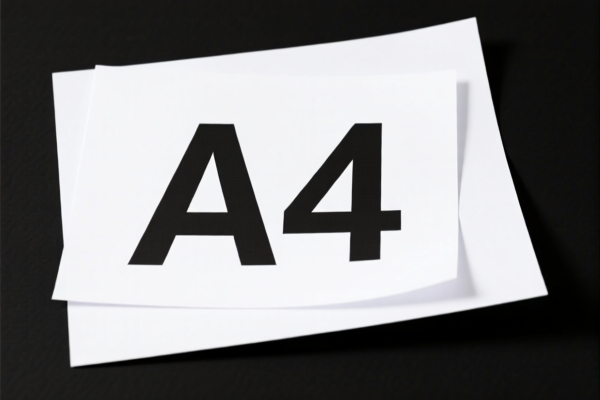| HS Code | Official Doc | Tariff Rate | Origin | Destination | Effective Date |
|---|---|---|---|---|---|
| 4802561000 | Doc | 55.0% | CN | US | 2025-05-12 |
| 4801000120 | Doc | 55.0% | CN | US | 2025-05-12 |
| 4801000140 | Doc | 55.0% | CN | US | 2025-05-12 |
| 4804110000 | Doc | 55.0% | CN | US | 2025-05-12 |
| 4804190000 | Doc | 55.0% | CN | US | 2025-05-12 |
| 4811592000 | Doc | 55.0% | CN | US | 2025-05-12 |
| 4811909035 | Doc | 55.0% | CN | US | 2025-05-12 |
| 4803002000 | Doc | 55.0% | CN | US | 2025-05-12 |
| 4803004000 | Doc | 55.0% | CN | US | 2025-05-12 |
| 3920710000 | Doc | 61.2% | CN | US | 2025-05-12 |
| 3919102055 | Doc | 60.8% | CN | US | 2025-05-12 |
| 3919905060 | Doc | 60.8% | CN | US | 2025-05-12 |




A4 Paper
A4 is a standardized paper size, part of the internationally recognized ISO 216 paper size system. It is the most commonly used paper size globally, widely utilized in offices, schools, and homes for a diverse range of applications.
Material
A4 paper is typically manufactured from wood pulp. The quality and composition of the pulp influence the paper's characteristics:
- Wood Pulp: The primary source material, varying in fiber length and processing methods.
- Brightness: Measured on a scale, indicating the paper's whiteness and reflectivity. Higher brightness is generally preferred for printing documents with sharp contrast. Common brightness levels range from 80 to 100.
- Weight (gsm): Denoted in grams per square meter (gsm), indicating the paper's density. Common weights include:
- 80gsm: Standard weight, suitable for everyday printing and writing.
- 100gsm: Slightly heavier, offering a more premium feel and improved durability.
- 120gsm+: Heavier weights used for presentations, brochures, or covers.
- Finish: Affects the paper's texture and appearance.
- Matte: Non-reflective, reducing glare and providing a softer appearance.
- Gloss: Reflective, enhancing color vibrancy and image clarity.
- Satin: A semi-gloss finish offering a balance between matte and gloss.
Purpose
A4 paper serves a broad spectrum of purposes:
- Printing: Documents, reports, essays, articles, and general text-based materials.
- Writing: Note-taking, letters, manuscripts, and creative writing.
- Copying: Reproducing documents using photocopiers.
- Drawing & Sketching: Depending on the weight and finish, suitable for light sketching and drawing.
- Crafting: Origami, paper models, and various artistic applications.
Function
The primary function of A4 paper is to provide a consistent and standardized surface for information recording and presentation. Its standardized size facilitates compatibility with printers, copiers, and filing systems.
Usage Scenarios
- Office Environments: General document printing, internal memos, reports, and correspondence.
- Educational Institutions: Assignments, essays, exams, and teaching materials.
- Home Use: Personal correspondence, bills, recipes, and creative projects.
- Graphic Design & Printing: Layouts, mockups, and final print production (depending on paper weight and finish).
Common Types
- Standard White Copy Paper: 80gsm, matte finish, suitable for everyday printing and copying.
- Premium White Paper: Higher brightness and weight (90-100gsm), offering improved print quality and a more professional appearance.
- Color Paper: Available in a wide range of colors for highlighting, presentations, or creative projects.
- Recycled Paper: Manufactured from recycled pulp, offering an environmentally friendly alternative.
- Photo Paper: Specifically coated for high-quality photo printing, available in various finishes (gloss, matte, satin).
- Cardstock: Heavier weight paper (160gsm+), used for business cards, invitations, and other durable applications.
A4 paper typically refers to uncoated paper used for writing, printing, or graphic purposes. Here are relevant HS codes based on the provided reference material:
- 4802561000: This HS code covers uncoated paper and paperboard used for writing, printing, or graphic purposes, which are not perforated punch cards or tape paper. It specifically applies to paper weighing between 40 g/m² and 150 g/m² in sheets with one side not exceeding 435 mm and the other side not exceeding 297 mm in the unfolded state. A4 paper falls within these dimensions. The tax rate is a base tariff of 0.0%, an additional tariff of 25.0%, and an additional tariff of 30.0% after April 2, 2025, resulting in a total tariff of 55.0%.
- 4811592000: This HS code covers coated or impregnated paper and paperboard with plastics (excluding adhesives). It applies to paper in strips or rolls of a width exceeding 15 cm or in rectangular sheets with one side exceeding 36 cm and the other side exceeding 15 cm in the unfolded state, specifically printing paper. If the A4 paper is coated, this HS code may be applicable. The tax rate is a base tariff of 0.0%, an additional tariff of 25.0%, and an additional tariff of 30.0% after April 2, 2025, resulting in a total tariff of 55.0%.
- 4811909035: This HS code covers other paper, paperboard, cellulose wadding, and webs of cellulose fibers, specifically paper in sheets, lined or ruled, having a width of 152.4 to 360 mm inclusive and a length of 225.25 to 360 mm inclusive. If the A4 paper is lined or ruled, this HS code may be applicable. The tax rate is a base tariff of 0.0%, an additional tariff of 25.0%, and an additional tariff of 30.0% after April 2, 2025, resulting in a total tariff of 55.0%.
It is important to determine whether the A4 paper is coated, lined, or ruled to select the correct HS code. If it is simply uncoated paper within the specified weight and dimension ranges, 4802561000 is the most appropriate choice.
Customer Reviews
No reviews yet.